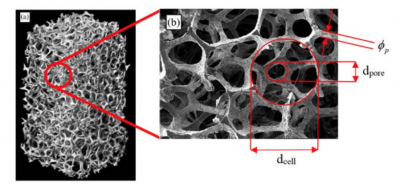(→) |
|||
| Line 14: | Line 14: | ||
* apply the validated numerical framework to identify the key contributing parameters to fouling mechanisms and its mitigation in porous metal foams in turbulent heated flows. | * apply the validated numerical framework to identify the key contributing parameters to fouling mechanisms and its mitigation in porous metal foams in turbulent heated flows. | ||
| − | === Foam Image === | + | <-- === Foam Image === |
{| class="wikitable" | {| class="wikitable" | ||
|[[File:Specimen.png|400 px]] | |[[File:Specimen.png|400 px]] | ||
|} | |} | ||
(a) Aluminium foam specimen image obtained via X ray computed microtomography [1] (b) magnified image of the specimen with d_cell ≈ 2.25 mm [2], d_pore ≈ 1 mm and φ_p ~ 0.25-0.45 mm | (a) Aluminium foam specimen image obtained via X ray computed microtomography [1] (b) magnified image of the specimen with d_cell ≈ 2.25 mm [2], d_pore ≈ 1 mm and φ_p ~ 0.25-0.45 mm | ||
| + | --|> | ||
{| class="wikitable" | {| class="wikitable" | ||
Revision as of 15:31, 1 April 2016
Contents
Flow, heat transfer & particle transport in metal foams
Context
Porous media are nowadays common materials in many thermal or mechanical engineering applications such as heat exchangers or oil/air separators [Ce2007]. However, since a few decades, a new type of such "macro- porous" media called metal foams often used in the engineering field has emerged. Compared to other standard materials, metal foams or metfoams constitute a new class of materials, known to have many interesting combinations of physical & mechanical properties.
Target Applications, Hurdles
Since the possible fields of applications of metal foams are very large, this project has the ambition to tackle the challenge of proposing a numerical/experimental methodology in order to create the design tools for next generation metal foams conception & optimization, by not only characterizing but also proposing & determining the more adapted macro/micro scale pore structure for each specific application. We shall mainly focus on developing a methodology for the design of high performance compact heat exchangers and heat sinks, e.g. in the context of the thermal management of direct thermo-electric converters or electronic devices coolers, for instance in the context of LED thermal management. Above the enhanced thermal conduction or the desired filtering, undesired particulate fouling is a common phenomenon in porous media/metal foams and may dramatically reduce the heat transfer efficiency.
Main objectives
The main research objectives are to:
- develop a numerical framework based on an Immersed Boundary Method (IBM) including a Level-Set technique for tracking the complex fluid/solid interface,
- incorporate for the first time all physical interactions between turbulent flow, particles and heat transfer in complex porous structures within the proposed framework while preserving high-order accuracy,
- enable systematic model validation through new pore-scale experiments on idealized and real foams for improved understanding of particulate fouling mechanisms in complex turbulent flows subject to heat transfer, and
- apply the validated numerical framework to identify the key contributing parameters to fouling mechanisms and its mitigation in porous metal foams in turbulent heated flows.
<-- === Foam Image ===

|
(a) Aluminium foam specimen image obtained via X ray computed microtomography [1] (b) magnified image of the specimen with d_cell ≈ 2.25 mm [2], d_pore ≈ 1 mm and φ_p ~ 0.25-0.45 mm --|>

|

|

|
1. Ranut, P., E. Nobile, and L. Mancini, Applied Thermal Engineering, 2014. 69(1-2): p. 230-240.
2. Dyga, R. and M. Placzek, Experimental thermal and fluid science, 2015. 65: p. 1-12.
Participants
Emilie Sauret, Sofiane Khelladi, Thomas Sarfati, Lucas Manueco, Eric Herbert, Yves D'Angelo.